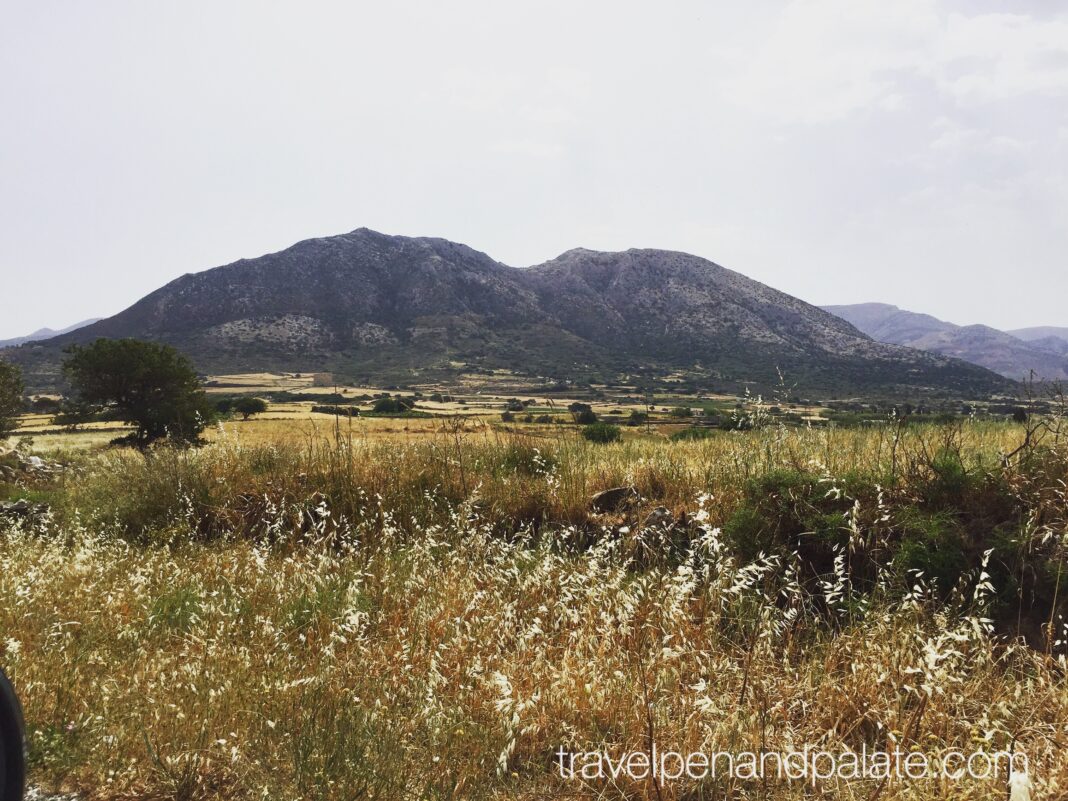“Hail, goddess, and nurse peace, that he who sows may also reap.” (Callimachus, poet, 3rd century BCE)
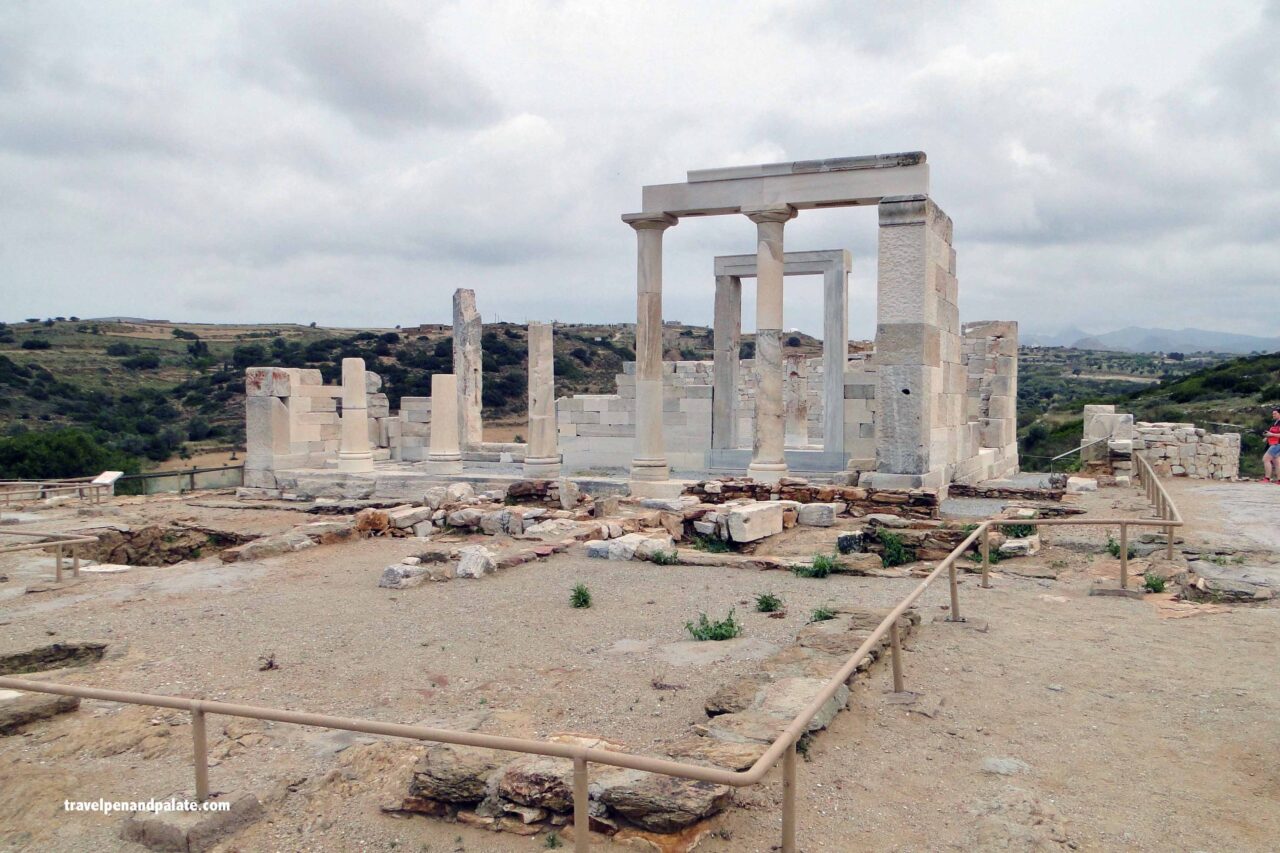
The Temple to Demeter overlooks the productive agricultural land of Naxos Island. Agriculture had made Naxos wealthy, and in the 6th century BCE the island erected the first all marble temple in the Greek world to the Goddess of Grain. Dionysus, god of wine and revelry, maintained one of his divine residences on the island.
It’s well known that Greeks are reverential toward their cuisine. The growing and preparation of food has been a bond for Greek civilization since ancient times. In a culture this old what are authentic recipes? Does a mother recipe exist for classic dishes?
My answer to these questions does not have to wait for the last paragraph. As a chef I have stated before, given for millenniums Greece’s geo-political location as a crossroad between Europe and Asia, that mother recipes would be unlikely. Regional recipes are the authentic variations on classics handed down through generations within the family and village.
Naxos Island and the Small Cyclades, Tinos Island, Andros Island, Aigio (on the Corinthian Gulf) and Mount Athos are representative of Greek culinary diversity. In the process both the classic dishes and the preparation techniques are alive in the 21st century.
Naxos Island and the Small Cyclades
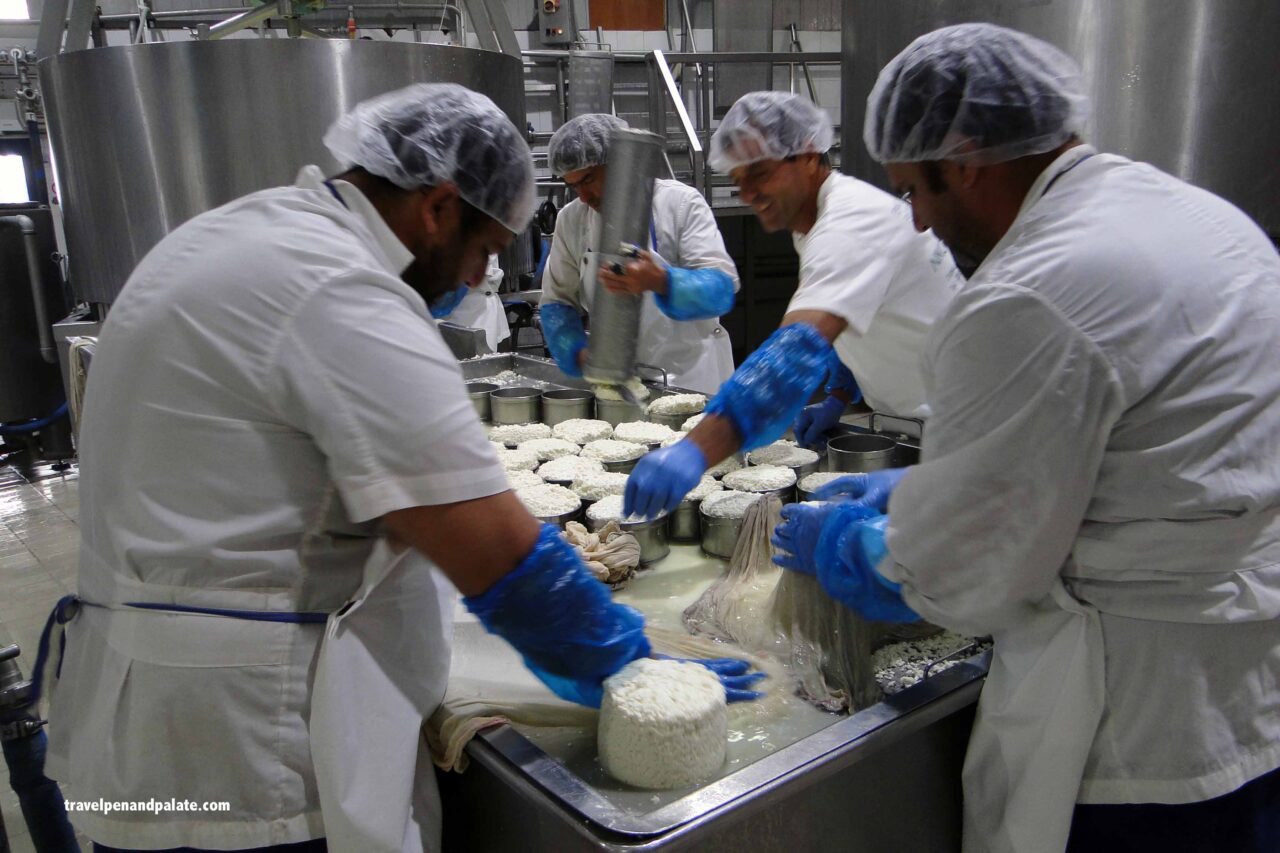
The Agriculture Union of Naxos, a co-op of local dairy farmers for the purpose of cheese manufactures, uses cow, sheep and goat’s milk. Kefalotyri Arseniko (“male” cheese) made with 100% sheep’s milk, has a bold, tangy flavor. Free-range sheep graze on a variety of wild herbs and grasses greatly influencing the flavor notes in the cheese. It’s frequently grated over pasta dishes.
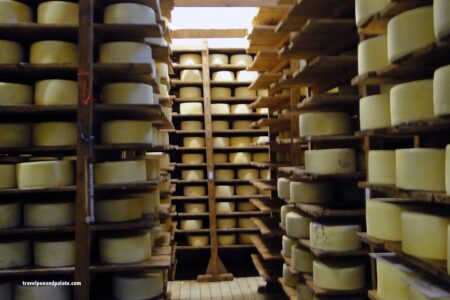
Naxos graviera is 80% cow and 20% goat/sheep’s milk. Distantly related to Swiss gruyere, this versatile, mild, hard cheese is second in popularity only to feta. It is served sliced with breads and charcuterie, fried as saganaki, grated over pasta dishes, baked in casseroles and added to salads.
Naxos feta has the tangy saltiness associated with making this cheese in the traditional manner. The flavorful sheep and goat’s milk (70% & 30%) of Naxos are used. Sheep and goat’s milk is unavailable from September through December. Tradition is not compromised; feta simply is not made those months.
Tinos Island:
At Metaxi Mas, in the Choro, I dined on savory Young Sheep with Lemon Thyme with Nikoleta Delatola Foskolou, cookbook author, restaurant consultant and culinary teacher. It was a simple slow braised dish relying on the full flavor of natural fresh ingredients.
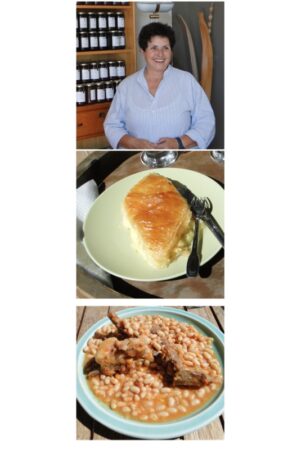
Tinos Island is a culinary force in the Cyclades (Tinos Food Paths, reviving Kariki cheese) and Nikoleta promotes the preservation of the basics through her writing and workshops. Many of the fruits and vegetables she uses are grown in the lush garden setting surrounding her home.
A tasting included Moustalevria made from grape juice extracted after the initial pressing. It is boiled and thickened to a soft custard consistency and served as a dessert sprinkled with sesame seeds and walnuts. The taste is subtle, not bold like grape jelly, with a pleasant texture contrast of crunchy nuts.
Moustalevria
- Boil 12 cups (3 quarts) grape juice until reduced to 6 cups.
- Reduce heat
- Wisk in 1 cup flour and stir gently until thickened.
- Pour into a shallow pan and sprinkle with nuts.
- Serve at room temperature.
A typical and savory Tinos dish of white beans cooked with pork ribs could almost have been from the southern United States. Classic Galaktopboureko, custard filo pastry rich in fresh milk and lemon zest, was silky smooth.
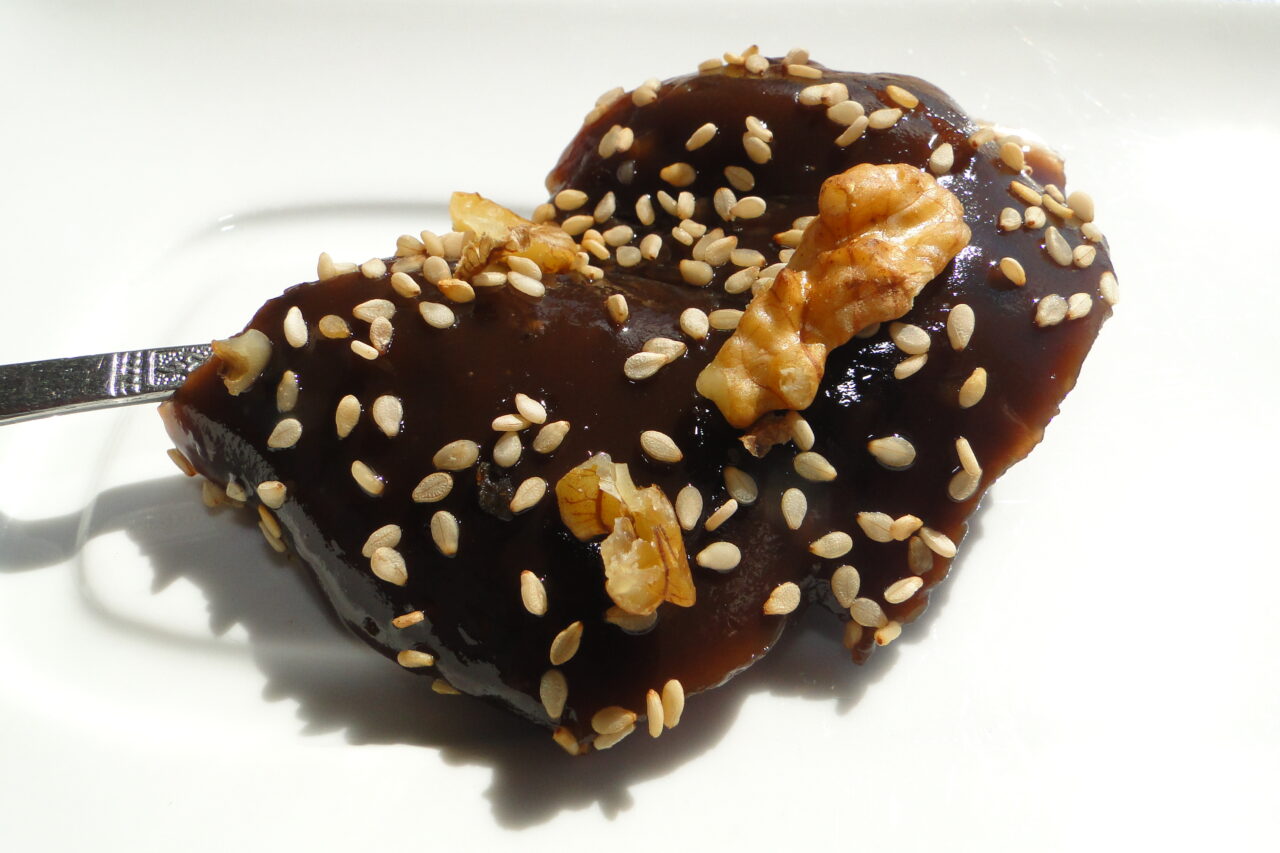
Andros Island
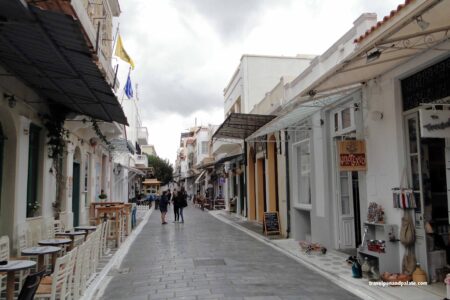
The streets of historic Choro (Andros Town) are paved in marble and lined with soft pastel painted houses, smart shops and cafes. Commanding views of the Aegean are common. Achilleas Grigorekekis beckoned me into his Paradosiako Pantopoleio of Andros while I was admiring his artistic food displays.
Achilleas narrow, compact shop is bursting with the premium preserved foods, cheeses, sausages and fruits Andros has to offer.
Pergamont and rose petals are made into a mastic-like paste for a traditional Submarine, but these flavors are particular to Andros.
Pampiloni, a large Andros citrus fruit, is often made into a spoon sweet. Flavorful spoon sweets have experienced a remarkable revival throughout Greece over the past few decades. Andros’ abundant walnut harvest provides a unique spoon sweet.

Pasteli, Andros Island’s variation on this delicious Greek sesame candy, is chewy rather than the crunchy wafers of other regions.
Pastelaries are butterflied fresh figs sundried then coated with a mix of ground almond, cinnamon, sesame seeds and floral infused water. The figs are dried again in a low oven.
Liastos (13.5% alcohol) was a traditional Andros Island home made wine from late harvest grapes. The grapes are sun dried for 10 to 15 days then crushed. Decidedly a dessert or digestive wine, the best tend toward a premium dry sherry in bouquet.
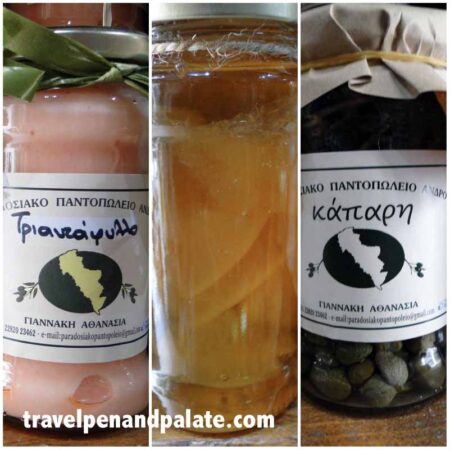
Omelet recipes appear in many culinary traditions. Since the introduction of potatoes to Europe in the 16th century they have been paired with eggs in many variations throughout the Mediterranean world.
On Andros Island a froutalia is a popular and easy omelet that can include sausage, artichokes, zucchini blossoms, cheese and, naturally, potatoes that grow well in Cyclades island soil
Potato and Sausage Froutalia is the island’s most beloved. Local smoked sausage with fennel or louzes is commonly used.
Louzes is smoked pork sirloin. After salting for 12 hours, it is hung over a slow burning fire of cypress wood smoking the meat for another 12 hours. The meat is then cut into pieces and browned in pork lard. After the meat is browned it is placed in a clay pot and covered with melted fat (glina).
Potato and Sausage Froutalia
Georget Photos provides an easy recipe in Joyful Cook’s Guide to Heavenly Greek Cuisine
Ingredients:
- Butter, olive oil or glina (melted pork fat)
- 4 eggs well beaten
- 8 ounces pork sausage with fennel or louzes (or experiment by substituting many other ingredients)
- 2 tablespoons chopped fresh basil or mint
- 2 to 3 medium size potatoes
- 2 ounces crumbled feta cheese
Preparation:
- Peel and thinly slice potatoes. Place them in a bowl of cold water.
- Heat the butter, oil or glina in a skillet with the herbs.
- Quickly pat the potatoes dry, and when the oil starts to sizzle add the potatoes. Reduce heat and cook for a few minutes. Turn them with a spatula and continue cooking for another few minutes.
- Add the sausage or louzes and brown carefully turning with a spatula not to break up the potatoes.
- Add the eggs, cover and cook until the top is firm enough to flip the omelet.
- Toss the feta on top and continue cooking until bottom is lightly brown.
Aigio (on the Corinthian Riviera)

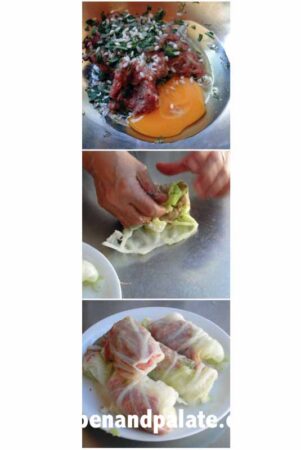
Eleni Kougia – Tsagri and her son Marios have the task of keeping 65-year-old Palia Agora tou Aigiou (The Old Agora of Aigio, aka Taverna Old Market of Aigio) fresh yet traditional. Housed in the historic 1895 market and under ownership of the 3rd generation, there’s no trick; it’s keeping the hands in the business.
Hands on is exactly what Chef Eleni demonstrated before lunch as she deftly handmade flaky phyllo dough for classic Tiropita. The fried feta cheese stuffed meze was a warm pillow.
Small, savory meat stuffed cabbage rolls in an aromatic stock were next on both the cooking list and lunch menu. The rolls were certainly a cousin to cabbage rolls common in northern Balkan countries, yet equally Greek. Greece is the southern most of the Balkan mountain system and culinary traditions are intertwined through millenniums of history.
On a practical note, fresh young grape leaves are available only early in the growing season or preserved in jars. Cabbages are available year round.
Lahanodolmades
Ingredients:
- 1 large cabbage, the head should have loose leaves.
- 2 1/4th pounds (1 kilo) ground beef, pork and/or veal
- ½ cup of rice
- 1 large red onion, finely chopped
- 1 green onion, finely chopped
- 1 large garlic clove, finely minced
- ½ cup of parsley, finely chopped
- 1/4 cup fresh dill, finely chopped
- 1/4 cup fresh mint, finely chopped (or 1 Tablespoon dried mint)
- ½ cup of extra virgin olive oil
- Salt and pepper
- Meat stock: chicken, beef, veal, rabbit
Preparation:
- In a large pot, bring salted water to a boil. Carefully remove the core of the cabbage, stick a fork in the center and boil cabbage until outer leaves become soft. Remove as many leaves as you can and continue softening and removing more leaves – closer to the core the longer they take.
- In a bowl mix the ground meat, rice, onion, parsley, herbs, salt and pepper, and 1/4th cup of the oil.
- If the leafs are very big cut them into pieces about 4 x 4 inches and remove any hard core. Add a heaped spoonful of minced meat (the amount of the filling will depend on the size of the leaf).
- Fold left edge and then right edge and then roll all the way. Wrap up into a cigar shape (don’t fold too tight as the rice will expand during cooking).
- Place neatly in the pot starting from the edge to the center. Second and third layers may be placed on top. IMPORTANT: cover with a plate the exact size of the pan so that when the lahanodolmades are steaming they will not open.
- Add the remaining olive oil and enough water or meat stock to just cover the plate. Bring to a boil, reduce heat and simmer for 45 minutes.
- When finished carefully remove with a slotted spoon.
- If you wish to serve the Lahanodolmades with avgolemono sauce reserve 1 cup of the cooking broth for its preparation.
The Holy Mountain Athos
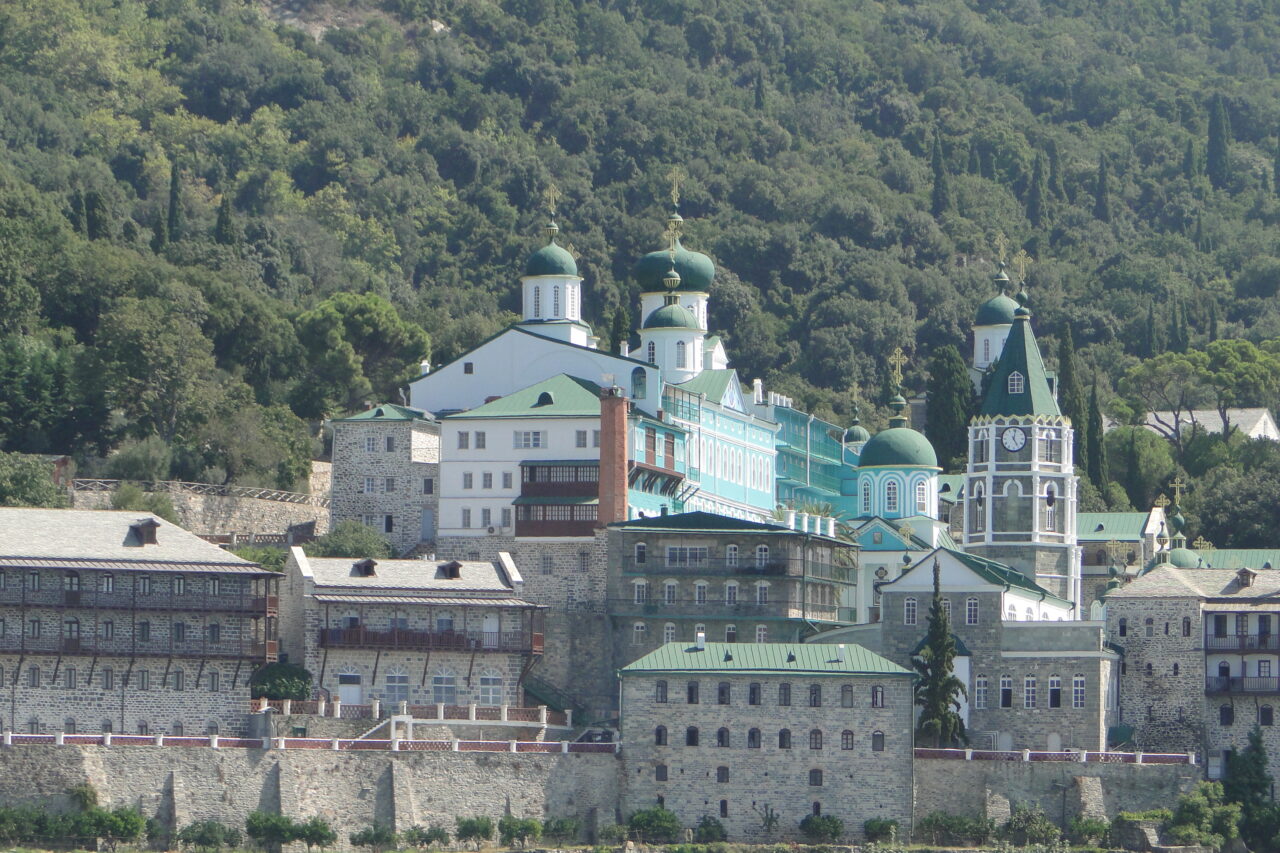
The monks have been there since the 8th century. Yet for millenniums Mount Athos had been sacred ground for the Pantheon. In the introduction to his best-selling cookbook, The Cuisine of the Holy Mountain Athos, renowned monk-chef Epiphanios of Mylopotamos pays homage to the timeless holistic connections among the divine, the Earth’s bounty and human life:
“He (the monk-chef) does not look with suspicion upon the ingredients he uses… modern science has not managed to diminish his confidence in wine and oil or the flavours and aromas that bring to mind Posdidon … (the) Titan Athos and Artemis the huntress.”
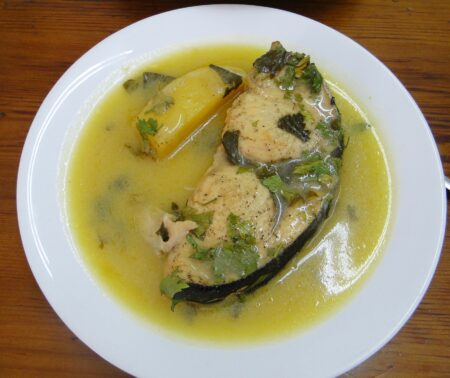
The cuisine is as legendary as the great monasteries. To enhance the natural flavors of each ingredient while achieving a union of aromas becomes a spiritual exercise. So does dining in the vast ancient halls.
Mount Athos meatless cuisine is focused on the abundance of fresh produce, fish and seafood from Halkidiki’s fertile fields and the Aegean Sea. Even after the introduction of New World produce into Greek cuisine from tomatoes to potatoes, Monk-chef Epiphanios commented, “One could claim that almost nothing changed in its principle characteristics.”
A recipe as simple as oven-baked potatoes with lemon pairs New World potatoes with Greek’s universal love of fresh lemons. Quartered potatoes are tossed with olive oil and herbs, roasted and spritzed with a generous amount of fresh lemon juice. It’s the perfect accompaniment to grilled fish.
The olive tree was a gift to mankind from Athena. Lemons were one of Hara’s three “golden apples,” and in the Andes Mountains of South America the Pacha Mama protected the potato. The melding of generations, belief systems and geographies are all quietly celebrated when gathered at a Greek table.
‘ΕχΩ ΦΑεΙ (I have eaten)
Travel with Pen and Palate every month to Greece and the world in the Hellenic News of America

Disclosure: The author was a guest of the businesses mentioned in this article. Arrangements were facilitated by: Re Make Consulting for Naxos Island, Pass Partout Tourism Marketing, DMC for Mt. Athos and the MTC Group for Andros Island, Tinos Island and Aigio.
Potato and Sausage Froutalia recipe courtesy of The Joyful Cook’s Guide to Heavenly Greek Cuisine (2016) by Georget Photos, W.R.Parks, Hershey, PA.




